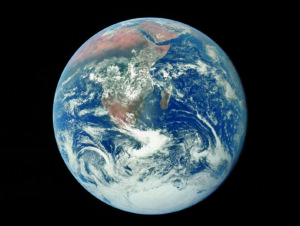“Everybody in the world needs to do this. Everybody in the world needs to see this.” These were the first words of 90-year-old William Shatner as he emerged, shaking with emotion, from a brief ride into space – where the former Star Trek actor had spent barely four minutes – aboard a Blue Origin rocket on October 13 2021.

by Apollo 17 astronauts.(Photo credits: NASA)
“This air that is keeping us alive,” he said.
As space travellers like Shatner have witnessed, our planet’s atmosphere seems as thin as the skin of an apple relative to the Earth. Although from our perspective it might appear limitless, we can alter its composition with emissions as easily as we can pollute vast lakes and oceans.
Yet many news reports covering Shatner’s journey neglected to mention his comments on the fragility of the Earth’s atmosphere: comments that could easily have been intended for delegates that attended the UN climate change conference COP26 in Glasgow.
Shatner’s voyage was made possible by Jeff Bezos’ space exploration company Blue Origin, founded in 2000, and has understandably been subject to criticism. Bezos, the billionaire founder of e-commerce giant Amazon, arguably achieved his astronomical success by hollowing out the cultural and commercial infrastructure of local areas across the globe: and has been condemned for spending billions expanding into the space tourism industry rather than improving the environment down on Earth.
The manned space programme of the 1960s and 1970s, run competitively by the US and Russia, was also criticised as a waste of money. But it yielded one huge and unexpected bonus: the first view of Earth from space, in all its majestic isolation.
At Christmas 1968, the crew of Apollo 8 became the first people to see and photograph the whole planet as they flew around the moon. From a quarter of a million miles away, the Earth’s unique beauty and vulnerability became apparent like never before.
During the voyage, astronaut Bill Anders took an unscheduled photo of the Earth partly in shadow, with the moon in the foreground. The moon’s bone-dead colours contrasted directly with the vibrantly-coloured, fertile Earth.
The photo, known colloquially as “Earthrise”, was later described by photographer Galen Rowell as “the most influential environmental photograph ever taken”. Years later, Anders reflected on his experience: “We came all this way to the moon, and yet the most significant thing we’re seeing is our own home planet.”
An inspiration
No sooner did the Earth become wholly visible than it sparked the rapid growth of the environmental movement, marked by the formation of the environmental charity Friends of the Earth in 1969 and the first UN Earth Summit in Stockholm in 1972. Commentator John Caffrey wrote in 1970 that “the greatest lasting benefit of the Apollo missions may be this sudden rush of inspiration to try to save this fragile environment – if we still can.”
In December 1972, the final Apollo mission (Apollo 17) captured possibly an even more famous image of the Earth, lit by the Sun at a distance of 28,000 miles: known as the “Blue Marble” photo.
Unlike Earthrise’s depiction of a half-shaded planet taken from the north, this photo showed the whole Earth from the south, including the first view of Antarctica. This view of a watery globe, centred on Madagascar rather than on a Western country, appeared as a photographic manifesto for global equality. With a human eye behind the lens, humankind found itself face to face with Mother Earth in an image that has become one of the most reproduced pictures of all time.
Actually travelling to space to see this transformative sight in person is, of course, impossible for the vast majority of the population. Since 1972, no human has left Earth’s orbit or seen the whole Earth, and very few ever will.
As a result, groups such as the Overview Institute and the Center for Planetary Identity have since come up with imaginative schemes to spread the environmental consciousness created by viewing the Earth from a distance to the wider population, including the use of virtual reality. As a historian and an environmentalist, I have a more modest proposal.
A new Blue Marble
Next year, 50 years will have passed since the Blue Marble photo: I think it’s time to take another. In December 2022, the Earth will be in a similar position relative to the sun as it was in December 1972. This will give a probe the opportunity to capture a photo of the full Earth from the same distance and angle as before, revisiting perhaps the most environmentally valuable achievement of the space age.
Although impressive images have since been captured of the whole planet by satellites, none offer the same perspective as the original image and most are composites patched together from multiple frames to show an idealised globe in perfect weather.
Although this image will still be beautiful, the planet it captures won’t be the same. Deserts like the Sahara will have expanded. Cloud systems will have altered. Antarctic ice will have retreated, and less green will be visible. Seen side by side, these two Blue Marbles, taken half a century apart, would bring home the consequences of climate change wordlessly, instantly and globally.
So, space billionaires: if you truly care about protecting our planet, let’s have the ultimate Earthshot. (The Conversation)



